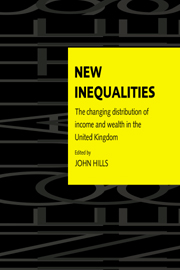Book contents
- Frontmatter
- Contents
- List of figures
- List of tables
- List of contributors
- Acknowledgements
- 1 Introduction: after the turning point
- Part I Income distribution
- Part II Components of income
- 6 What has happened to the wages of men since 1966?
- 7 Women's pay and family incomes in Britain, 1979–91
- 8 More work in fewer households?
- 9 Self-employment and the distribution of income
- 10 Fairer or Fowler? The effects of the 1986 Social Security Act on family incomes
- Part III Spatial aspects
- Part IV Income and wealth
- Bibliography
- Index
7 - Women's pay and family incomes in Britain, 1979–91
from Part II - Components of income
Published online by Cambridge University Press: 22 September 2009
- Frontmatter
- Contents
- List of figures
- List of tables
- List of contributors
- Acknowledgements
- 1 Introduction: after the turning point
- Part I Income distribution
- Part II Components of income
- 6 What has happened to the wages of men since 1966?
- 7 Women's pay and family incomes in Britain, 1979–91
- 8 More work in fewer households?
- 9 Self-employment and the distribution of income
- 10 Fairer or Fowler? The effects of the 1986 Social Security Act on family incomes
- Part III Spatial aspects
- Part IV Income and wealth
- Bibliography
- Index
Summary
Overview
One of the most striking trends in Britain over the past 10–15 years is the sharp rise in the labour force participation of women. Despite women's increased participation, other aspects of their labour force activity remain unchanged. Women still tend to be clustered in female-dominated occupations and, compared to men, they are still disproportionately likely to be working part-time, and to be low paid.
At the same time, Britain has seen a dramatic rise in the poverty rate and a sharp increase in family income inequality (see Goodman and Webb, 1994). There is now no doubt that, since the mid-1970s, the rich have become richer, and the poor have become poorer. But what has been in doubt is what, if any, relationship exists between women's work patterns and pay on the one hand and family poverty and inequality on the other. One school of thought suggests that, since many women work part-time and are married to male earners, their earnings are essentially ‘pin money’ and their low pay is of little consequence. An alternative view would be that since many women are married to low earners, or are living on their own, their earnings are an important component of family income and hence their low pay has important consequences for family poverty and family income inequality.
In this chapter we assess these alternative perspectives by investigating the links between trends in women's earnings and in family incomes over the period 1979–91.
- Type
- Chapter
- Information
- New InequalitiesThe Changing Distribution of Income and Wealth in the United Kingdom, pp. 158 - 180Publisher: Cambridge University PressPrint publication year: 1996
- 10
- Cited by



